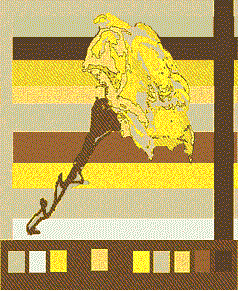5800 St Dennis Street studio 501
Montreal Quebec H2S 3L5
Since 1990, she is President of the “Conseil des métiers d’art” of Québec. Cofounder of the “Centre des métiers d’art en construction textile” of Montréal, she is also director of the school where she teaches textile creation on computers.
Or two weeks of play at the Montreal Centre for Contemporary Textiles.
First it’s repeat repeat repeat actually first it is arrive in Montréal at least a day in advance of the workshop and find your neighbourhood spot. A place where you can cool out (and believe me you will need it) this time around (this is my second time taking these workshops and my third visit to the centre) this time I was staying over by Concordia and found Café Fuego at 1846 Ste Catherine Quest in the block west of Rue St Mathieu. Great Patio in shades of Ochre, Beige and Black, strong coffee, great sandwiches and Gelato it is an envelope of comfort.

Well this was my second attempt like or not it is what it is. This design is created in a Pattern Window which has a set of tools and commands that are different then those provided by Photoshop and other design software. The way the Colours operate is very specific to the next step in the soft ware which is the Jacquard Cloth Window. In this window weaving structures are assigned to each specific colour.
A simulation of the weaving is generated by the software and gives you a fair example of what the final weaving will look like. 1 warp (white) 1 weft (colour)
But the reality is you are learning new software and it is weaving and you are required to check and recheck because if you don’t what you think is a nice one inch repeat ends up being a 8 inch wide image that repeats 4 and a half times instead of 42
I became obsessed with the idea of making my own upholstery for my couch, and played a bit with other designs (which where supposed to be a brocade which is learned on the first day of the second week) but I open the file while still have another file open and the structures where replace by the old file and blah blah blah. This is a unfortunate deficiency in the software I think, but knowing this can happen should make you more conscious of safe working procedures, but I find accidents and mistakes provide future source material so here is a mistakes from day one of week two ( again it is a repeat and should have been a brocade, but I lost the second weft when I open it after looking at the first repeat Jacquard Cloth Window)
Though this design had a mistake that means starting over they gave me a better starting point then my first design a sample of which was woven with an orange cotton weft on a white cotton warp and is quite frightening really looks like something a teenage girl of quickly approaching middle age pop starlet would wear as a skirt.
Afternoon session
Shaded Satins and Twills, classics in textile construction and yet used artistically, efficient at rendering photographic images. I will let them speak for themselves.



Step One: First you take a scanned image, then using the Pointcarré software you bring down the number of greys in the image (and there are more then you can imagine) to 13
Step Two: Assign 1 Warp (white) 1 Weft (brown) a sequence of weave structures that go through a monochromatic grey scale of light to dark
Step Three: push a couple of buttons and tada a simulation, a Shaded twill (not woven) the obvious difference from image one to image three above is the stretching that has occur and it is at this point you go back into the software to make corrections to achieve the proper shape and scale.


























